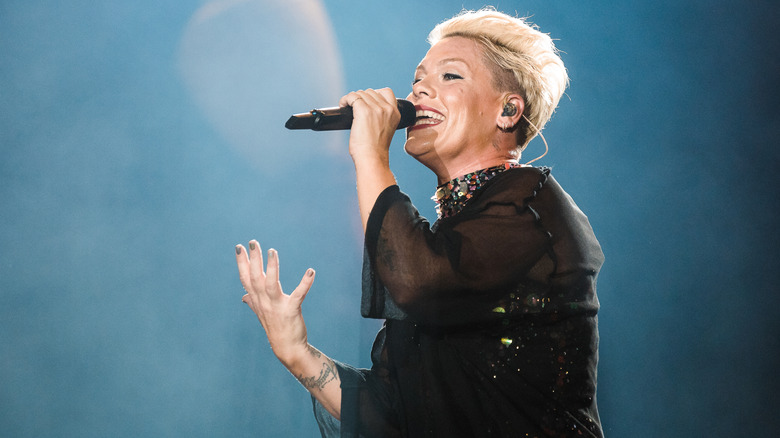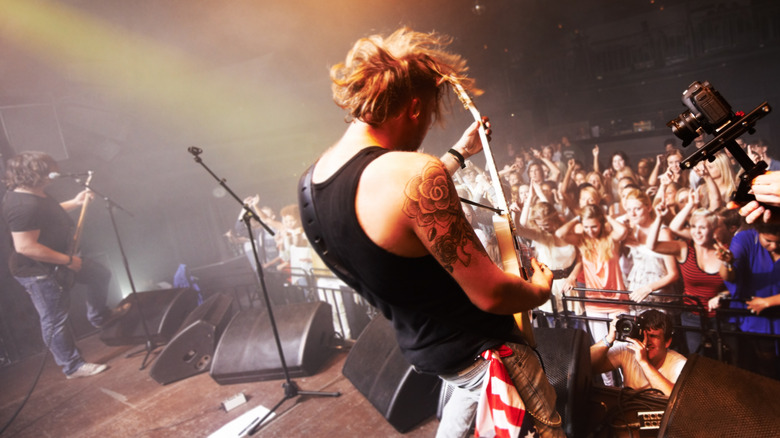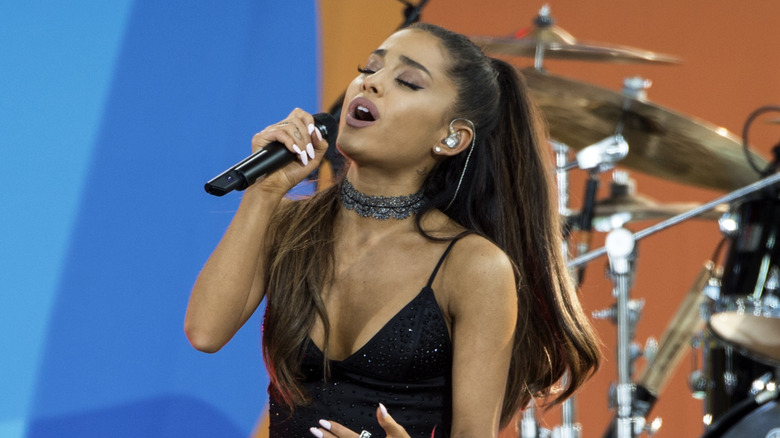What Are Those Earpieces Singers Wear During Live Shows?
If you're a fan of live music, you probably know that sound can make or break a show. From poor mixes to full-blown technical disasters, some sound issues are enough to make musicians storm off during live performances, causing their concerts to devolve into chaos. Unless they're lip-syncing like Ashlee Simpson on "SNL" circa 2004 (sorry, too soon?), it's next to impossible for singers to put on a good-sounding show if they can't hear themselves onstage.
This is where the earpiece comes in. Maybe you've seen your favorite artist rocking one at a concert before and mistook it for a hearing aid or a Bluetooth earbud. Though similar in size, that tiny device nestled inside their ear is actually an in-ear monitor (IEM) that allows them to hear themselves clearly. If it weren't for that small but mighty earpiece, they'd only be able to hear themselves through the speaker system, which — as you can imagine — is hard to do amidst a crowd of screaming fans. So next time you're at a concert, keep an eye out for that earpiece. Without it, your favorite singer might otherwise fall flat.
Before the earpiece
Though most artists today don't get onstage without them, earpieces haven't always been around. The earliest version dates back to 1965, when 13-year-old Stephen Ambrose designed a homemade in-ear monitor fashioned after swimming earplugs. However, it took until the 1980s for the modification of his innovative design to make it into the ears of performers like Stevie Wonder, Diana Ross, and Simon & Garfunkel.
Prior to the earpiece, many artists relied on small on-stage speakers known as wedges, which didn't come around until the 1960s. Acting as a monitor, the aptly named wedge-shaped speakers were planted on the stage pointing toward the performers as opposed to the audience. In 1961, Judy Garland became the first known performer to use wedge speakers for her concert at the San Francisco Civic Auditorium, a sensational show that drew in over 8,000 people. Not long after, at an Atlanta stadium show in 1965, the Beatles used wedge stage monitors for the first time. Finally able to hear themselves over the rapturous screams of Beatlemania, Paul McCartney proclaimed mid-concert, "It's loud isn't it? Great!" (via Beatles Bible). Soon, other bands like the Who followed suit, utilizing stage monitors in the late 1960s and the 1970s.
The don of the earpiece
Wedges worked for a while (and are still used today), but they came with plenty of problems, such as hearing damage and poor sound quality. Plus, they weren't compact enough for performers to cart around on stage. The alternative to wedges surfaced in the 1980s when audio innovator Marty Garcia teamed up with Todd Rundgren of the rock band Utopia to create custom-fit earphones. In 1985, Utopia became the first band to replace wedges with ear monitors on stage, but Stevie Wonder was the first to sport a wireless version developed by his sound engineer, Chrys Lindop. Modifying Stephen Ambrose's 1965 design, Lindop used an FM transmitter to create the new model. Though the device allowed Wonder to hear himself on stage, it didn't grant much in the way of auditory health and was fine-tuned over the years.
In 1995, Van Halen's monitor engineer, Jerry Harvey, invented a two-driver in-ear monitor for drummer Alex Van Halen, whose ear health was suffering due to the blasting amps and on-stage monitors. It wasn't long before the innovative earpieces began to catch on. While on tour with Van Halen, the members of Skid Row reportedly offered the band $3,000 each for their own in-ear monitors (per Beth Roars).
Nowadays, earpieces have become more commonplace, and ProSoundAudio says they average around $89 per pair. They're used religiously by big-name artists like Taylor Swift, whose earbuds not only help her hear herself but also give the added guidance of countdowns and performance cues. In addition to their auditory benefits, earpieces have also become somewhat of an accessory, with artists like Ariana Grande sporting bejewelled buds during performances for added flair. Boasting both function and fashion purposes, in-ear monitors keep your favorite singer looking and sounding good live.


